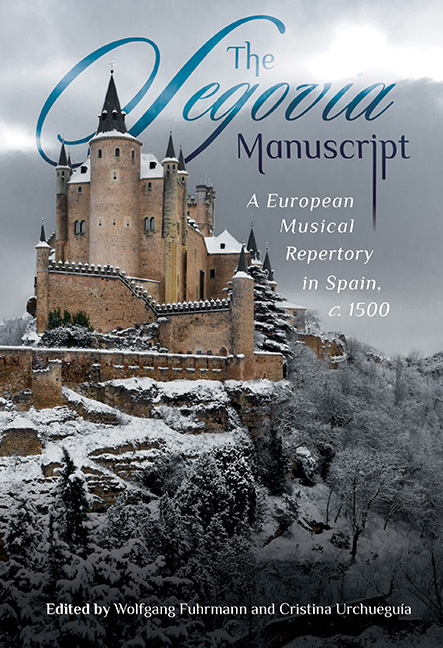Book contents
- Frontmatter
- Contents
- List of Illustrations
- Notes on Contributors
- Abbreviations
- Preambulum: A Source in Segovia
- 1 In Search of Origins: The Afterlife of a Renaissance Manuscript
- 2 New Light on the Segovia Manuscript: Watermarks, Foliation, and Ownership
- 3 Segovia's Repertoire: Attributions and Datings (with Special Reference to Jacob Obrecht)
- 4 What Was Segovia For?
- 5 The Latin Texts of the Segovia Manuscript
- 6 The Segovia Manuscript as Chansonnier
- 7 The Segovia Manuscript: Another Look at the ‘Flemish Hypothesis’
- 8 The Segovia Manuscript: Speculative Notes on the Flemish Connection
- 9 The Written Transmission of Polyphonic Song in Spain c. 1500: The Case of the Segovia Manuscript
- 10 Inventory of Segovia, Archivo Capitular de la Catedral, MS s.s.
- Bibliography
- Index of Compositions
- General Index
- Miscellaneous Endmatter
Preambulum: A Source in Segovia
Published online by Cambridge University Press: 29 March 2020
- Frontmatter
- Contents
- List of Illustrations
- Notes on Contributors
- Abbreviations
- Preambulum: A Source in Segovia
- 1 In Search of Origins: The Afterlife of a Renaissance Manuscript
- 2 New Light on the Segovia Manuscript: Watermarks, Foliation, and Ownership
- 3 Segovia's Repertoire: Attributions and Datings (with Special Reference to Jacob Obrecht)
- 4 What Was Segovia For?
- 5 The Latin Texts of the Segovia Manuscript
- 6 The Segovia Manuscript as Chansonnier
- 7 The Segovia Manuscript: Another Look at the ‘Flemish Hypothesis’
- 8 The Segovia Manuscript: Speculative Notes on the Flemish Connection
- 9 The Written Transmission of Polyphonic Song in Spain c. 1500: The Case of the Segovia Manuscript
- 10 Inventory of Segovia, Archivo Capitular de la Catedral, MS s.s.
- Bibliography
- Index of Compositions
- General Index
- Miscellaneous Endmatter
Summary
The Segovia Manuscript, preserved in the Archivo Capitular of the beautiful late Gothic cathedral of Segovia in the Spanish region of Castilla-León, has puzzled scholars ever since its rediscovery at the beginning of the twentieth century. Curiously, it is the only musical manuscript in this archive that lacks a signature, a sign of its singularity. In content and form it is unique: no other extant Spanish manuscript transmits a comparable combination of late fifteenth-century music: the Segovia manuscript contains music by northern French, Flemish, and Spanish composers. The repertory is mixed, containing sacred works and vernacular pieces in Spanish, Flemish, French, and Italian, and, last but not least, some instrumental pieces. This summary might suggest a haphazard, messy collection, but on the contrary we find a manuscript arranged with care, copied by a few proficient scribes, who obviously followed a predetermined masterplan. But which plan, who designed it, and why was the person responsible so interested in this combination of works?
Let us first introduce the main features of the manuscript. A new examination of the manuscript in 2008 confirmed the description given in RISM B XV: 207 paper sheets of an original minimum of 228 have survived, measuring 291 × 215 mm. The pages have been trimmed: some ascriptions of the 204 transmitted pieces have been partially cut at the top but all are still legible. Four numbered folios are missing at the beginning and others at several points in the volume, causing the fragmentation of some works; a single folio (now 9b) has been displaced – details may be found in the inventory at the end of this book. A limp parchment binding with the inscription ‘canto de organo’ – the Spanish expression for polyphonic music in the fifteenth and sixteenth centuries – preserves the extant portion of the book, which was probably damaged very early after its production, and certainly before binding. At some point between 2000 and 2007 the manuscript underwent a very careful and respectful restoration, which included essential measures for its preservation, including cleaning, the stabilization of the most badly damaged sheets, the prevention of ink corrosion, and the renewal of the seams of the binding.
- Type
- Chapter
- Information
- The Segovia ManuscriptA European Musical Repertory in Spain, c.1500, pp. 1 - 6Publisher: Boydell & BrewerPrint publication year: 2019



